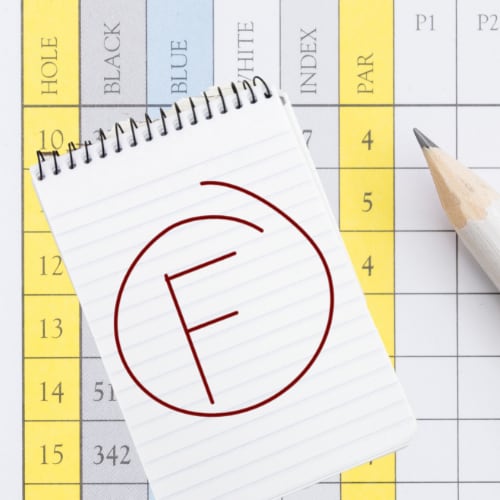Golf is a sport that requires a combination of skill, strategy, and a bit of luck. It’s a game that can be enjoyed by players of all ages and skill levels. But what is considered an average golf score for an average golfer?
The answer to this question isn’t straightforward, as there are many factors that can affect a golfer’s score. However, by looking at data and statistics, we can get a general idea of what an average score might be for someone who plays golf regularly.
In this article, we’ll take a closer look at what the average golf score is for an average golfer, provide detailed context for understanding what it means, and offer tips for improving your score.
- 1) What Do Most Average Golfers Shoot?
- 2) What Is the Average Score for 18 Holes?
- 3) What Is the Average Score for 9 Holes?
- 4) Average Golf Score By Age
- 5) What Does a Decent Golfer Shoot?
- 6) What Is A Bad Golf Score?
- 7) Factors To Consider In Calculating Average Scores
- 8) How to Calculate Your Average Score?
- 9) Final Thoughts
What Do Most Average Golfers Shoot?

As a recreational golfer, you might wonder what an average score would be for someone like you at a typical golf course. According to data collected by the USGA (1), the average golfer shoots around 100 for an 18-hole round on a par 72 course.
Of course, your actual score may vary depending on several factors, including your skill level, equipment, and the course you’re playing on. To get a better idea of your true skill level, you can use the handicapping system provided by the USGA and other major golf authorities.
For a better and deeper understanding of the handicap system, we invite you to read our detailed article about what a handicap is and how to calculate it.
Your handicap rating is a measure of your potential ability, and it’s calculated based on your previous scores. By submitting your golf scores to the USGA, you can easily calculate your handicap and compare it to the average for your skill level.
The USGA has established a range of handicap ratings to help classify golfers and make scoring achievements more meaningful.
For example, a scratch golfer is someone who has a handicap of 0 or better, meaning they can play an “even” round of golf.
A low handicapper is anyone scoring between 1 and 9, also called a single-digit handicap.
A mid-handicapper has a handicap of around 9 to 18 and will shoot around 90 on a typical course.
A golfer who constantly scores 20 over par or more is considered a high handicapper.
What Is the Average Score for 18 Holes?
On average, male golfers shoot around 90 and female golfers shoot around 110. However, these scores can vary greatly depending on skill level and age. Different golf scoring variations like best ball and scramble can also affect average scores in team play situations. Junior golfers, for example, may shoot much lower scores than adult amateur players.

Advancements in golfing gear have also had an impact on average scores. With improved clubs and balls, golfers are now able to hit the ball farther and with greater accuracy, leading to lower scores. However, at the professional level, courses have been lengthened and made more challenging to offset these advancements.
In terms of strokes per hole, the average number of strokes for men is around 4.5-5 while for women it’s around 5.5-6.5. But keep in mind that these numbers can vary greatly depending on the hole’s difficulty and your skill level.
Course rating, slope factor, and handicap ratings are important concepts to understand in relation to your average score.
The course rating reflects the expected score of a scratch golfer (someone who shoots par) while the slope factor reflects the difficulty of the course for a bogey golfer (someone who typically shoots one stroke above par per hole).
Handicap ratings take into account both the course rating and slope factor to reflect how difficult a course is for a particular player.
What Is the Average Score for 9 Holes?
Factors like skill level, frequency of play, and course difficulty can greatly influence your scores for 9 holes.
On average, golfers shoot around 45-50 strokes for 9 holes. However, this score can vary from 30 to 70 strokes depending on the factors mentioned above.

For beginners and amateurs, playing on a par 3 course is an excellent way to improve their scores. Par 3 courses are shorter and have smaller greens, making it easier for beginners to get closer to the hole. The excitement of a hole-in-one opportunity on a par 3 course can give beginners a sense of accomplishment and encourage them to continue playing.
A hole-in-one on a par 3 course can have a significant impact on your 9-hole score. For example, if you score a hole-in-one on a par 3, your score for that hole would be 1 stroke instead of the average 3 strokes.
Average Golf Score By Age

Average golf scores can vary greatly depending on age and skill level. Here is a breakdown of average golf scores by age group; these numbers are for the most part based on data from mygolfspy.com (5):
- 20-30: The average score is 89.7
- 30-40: An average of 91.7
- 40-50: An average score of 91.5 for men and 100 for women.
- 50-70: An average score of 91 for men and 103 for women.
- Over 70: An average score of 93.2 for men and 112 for women.
It’s important to keep in mind that these are just averages and there can be a significant statistical variation between individual scores.
The fluctuation in scores through the decades of a golfer’s life can be attributed to a variety of factors. In younger age groups, scores may be lower due to physical strength and ability, while scores may increase as golfers age due to physical limitations.
Additionally, experience and skill level play a significant role in a golfer’s score.
The methodology used to gather this information primarily involves self-reporting of scores through the GHIN (Golf Handicap and Information Network) system in the United States.
However, this can potentially introduce biases as it relies on golfers to accurately and honestly report their scores.
What Does a Decent Golfer Shoot?
A decent golfer is someone who exhibits a certain level of proficiency in the game of golf. This is highly subjective and may vary based on factors such as gender and level of play.

Generally, a decent golfer will have the ability to shoot scores that are at or near par for a given course.
For beginners, a decent score would be considered anything below 100 strokes for an 18-hole course. As golfers progress and become more experienced, they can expect to achieve scores in the 80s or even the 70s.
Professional golfers, on the other hand, may shoot scores that are significantly lower, with some players regularly shooting scores in the 60s. One example is Tiger Woods’ 59 score at the Isleworth Country Club in Windemere, Florida, one week before the 1997 Masters.
Most golf courses are par 72, meaning a score of 72 or below is typically considered good for a decent golfer. However, this does not mean that a score above 72 is considered bad, as there are many factors that can influence a golfer’s performance on any given day.
For professional golfers, the average score for 18 holes is around 71-72 strokes. This is largely because they possess a higher level of skill and are capable of executing shots that may be near-impossible for most amateur golfers.
For amateur golfers, the definition of a good golf score may vary based on personal goals and skill levels. However, in general, scores below 100 strokes on an 18-hole course are considered respectable and indicative of a decent golfer.
What Is A Bad Golf Score?
A bad golf score is a score that is significantly higher than what is expected for a particular player’s skill level and handicap. In general, any score that is higher than the average score for an average golfer would be considered a bad score.

There are several situations that can lead to a high score in golf. For example, hitting the ball into the rough or a sand trap can cause a player to take additional strokes to get back on the fairway or green. Missing short putts can also add strokes to a player’s score. Other factors that can contribute to a high score include poor course conditions or unfavorable weather.
One important factor to consider when determining what is considered a bad golf score is a player’s handicap. If a player shoots significantly higher than their typical score, then this score could also be considered bad. For example, if a player typically shoots in the mid-80s but scores over 100 on a particular day, this would be considered a bad score.
There are various score ranges that are commonly considered bad for both 18-hole and 9-hole courses. For an 18-hole course, a score over 100 would generally be considered bad for an average player, while a score over 120 would be considered bad for a beginner.
For a 9-hole course, a score over 50 would be considered bad for an average player, while a score over 60 would be considered bad for a beginner. However, these score ranges may vary depending on the golfer’s skill level and handicap.
Factors To Consider In Calculating Average Scores

Calculating an average golf score involves taking into consideration several factors. These include the following:
Course Rating
Course Rating is a number that represents the expected score of a scratch golfer on a particular course. This number is then used to calculate the expected score of golfers with different handicaps. In other words, the Course Rating is a way to determine the relative difficulty of a golf course, and it plays a significant role in calculating your average golf score.
Some factors that impact Course Rating include the length of the golf course, the number of hazards on the course, and the overall difficulty of the greens. Keep in mind that the higher the Course Rating, the more difficult the course is perceived to be. Golf courses are rated by the United States Golf Association (USGA) to determine their Course Rating.
When calculating your average golf score, it is essential to factor in the Course Rating of the course you are playing. For instance, if you are playing on a course with a Course Rating of 72, the expected score for a scratch golfer is 72. However, an average golfer with a handicap of 18 may have an expected score of 90 on the same golf course.
Slope Rating
Slope rating is a number that is used to adjust your handicap based on the difficulty of a specific golf course, and is measured on a scale of 55 to 155. The higher the Slope Factor number, the more difficult the course is considered to be.
Examples of the most difficult courses in the world include Bethpage Black, NY, USA, with a course rating of 77.5 and a slope rating of 155 (6.825 Km length) and the PGA Catalunya Resort, Spain with its 155 slope rating and around 6.227 Km length (3.87 miles).
It’s important to note that the Slope Factor works in conjunction with the course rating, which measures the difficulty of a course for scratch players (golfers who shoot par). Together, these ratings provide a more accurate representation of a golfer’s skill level and potential score on a specific course.
Here’s an example of how to use the Slope Factor and Course Rating to calculate an average golf score:
- Determine the Slope Rating and Course Rating for a specific course. Let’s use a fictional course with a Slope Rating of 120 and a Course Rating of 72.
- Subtract the Course Rating from your average score. Let’s say your average score on this course is 85. 85 – 72 = 13.
- Multiply the result by the Slope Factor and divide by 113 (which is the standard Slope Rating for male golfers). 13 x 120 / 113 = 13.8.
- Round your final result to the nearest whole number to get your adjusted handicap for this specific course. In this example, your adjusted handicap would be 14.
Handicap Ratings
A Handicap Rating is a measure of an average golfer’s playing ability based on a standardized formula. This rating is used to adjust a golfer’s score in relation to others with different skill levels, thereby making the game fairer when playing against one another.
Depending on your Handicap Rating, you will fall into one of three categories: low, mid, or high. A low handicap golfer typically has a handicap rating of 0-10, a mid-handicap golfer has a rating of 11-20, and a high handicap golfer has a rating of 21 or higher.
To calculate your Handicap Index, you must first use your golf course’s Course Rating and Slope Rating. Once you have these values, you can follow the steps below:
- Calculate your adjusted score: take your gross score and subtract your handicap allowance, which is usually equal to your handicap rating multiplied by the Slope Rating divided by 113.
- Find your Handicap Differential: this is the difference between your adjusted score and the Course Rating, multiplied by 113 and divided by the Slope Rating.
- Calculate your Handicap Index: this is the average of your lowest Handicap Differentials multiplied by 96%.
Your Handicap Index is then used to determine your net score, which reflects the score a player would have on a hole after factoring in their Handicap Rating. This is important because it allows players of different skill levels to fairly compete against one another.
How to Calculate Your Average Score?

Calculating an average golf score involves taking into account the course rating, slope rating, and expected score for a scratch golfer.
Using these three factors, you can calculate an average golf score by following this formula:
Average golf score = (Course Rating + (Average player’s expected score – Scratch golfer’s expected score)) x (Slope Rating/113) + Adjustable Score Differential
It’s important to note that there are other factors to consider when calculating an average golf score. These include course difficulty, age, and experience of the player. A beginner golfer will have a different average score than an experienced player, and playing on a difficult course will result in higher scores.
Final Thoughts
Tracking your golf scores is an essential part of the game. Understanding your averages, especially compared to other golfers, can help you define areas of improvement and keep you motivated.
Remember, your golf score is not the only measure of success. Every round is an opportunity to learn and improve your game. Continue practicing your golf swing, selecting the right equipment, and playing safe, smart shots. Use technology to help track your scores and progress towards a lower handicap.
By understanding where your results sit with other golfers, you can work on setting realistic goals with tangible progress markers. With your new gear and improved golf game, you will soon be beating your friends and playing like a pro!
Good luck, and remember the key to improving your golf score is having fun while doing it.
References:
- United States Golf Association. U.S. Handicapping Statistics. https://www.usga.org/handicapping/us-stats.html
- Nancy Berkley. THE NUMBERS!. http://nancyberkley.com/774894.html
- National Golf Foundation. https://www.ngf.org/fortnight/
- OVERALL GOLFER PERFORMANCE BY AGE. https://mygolfspy.com/labs/study-overall-golfer-performance-by-age/





